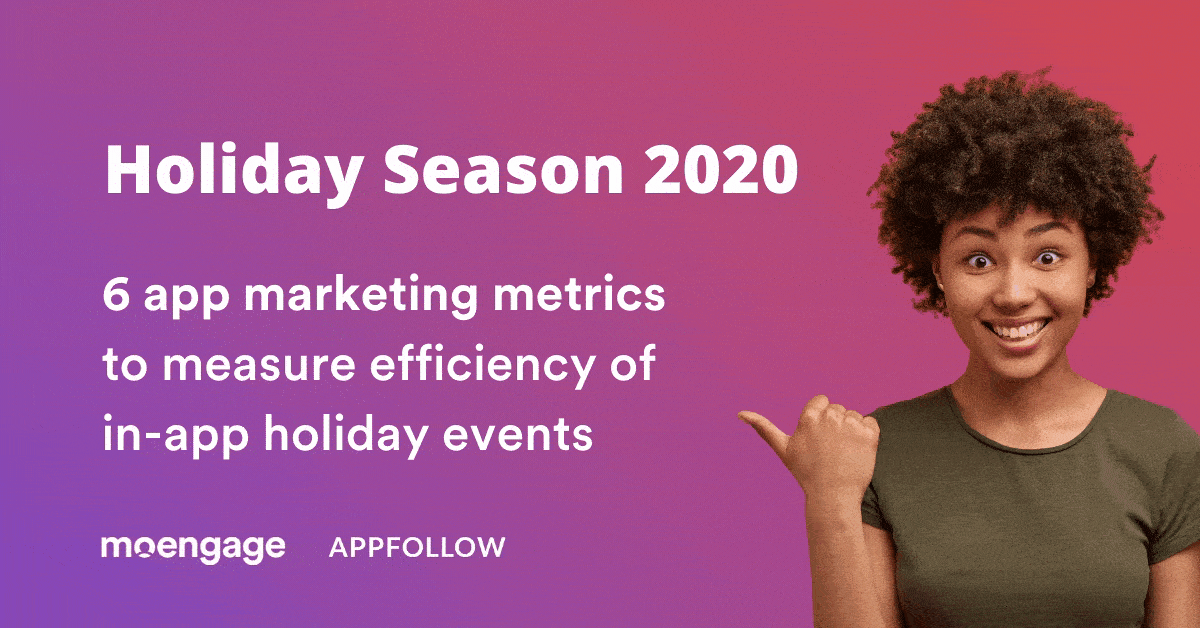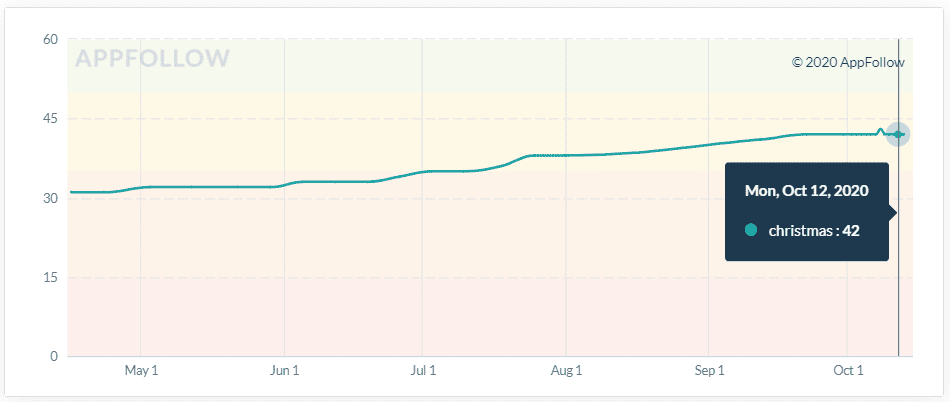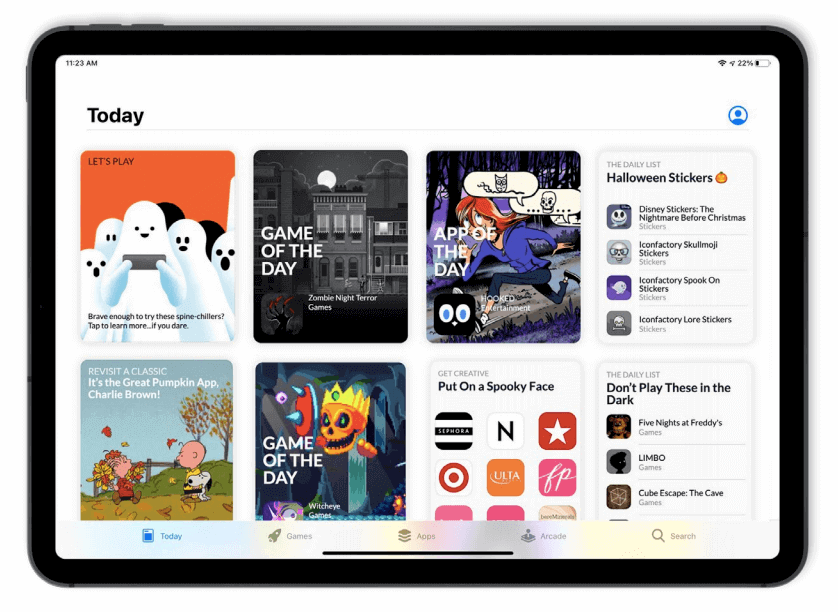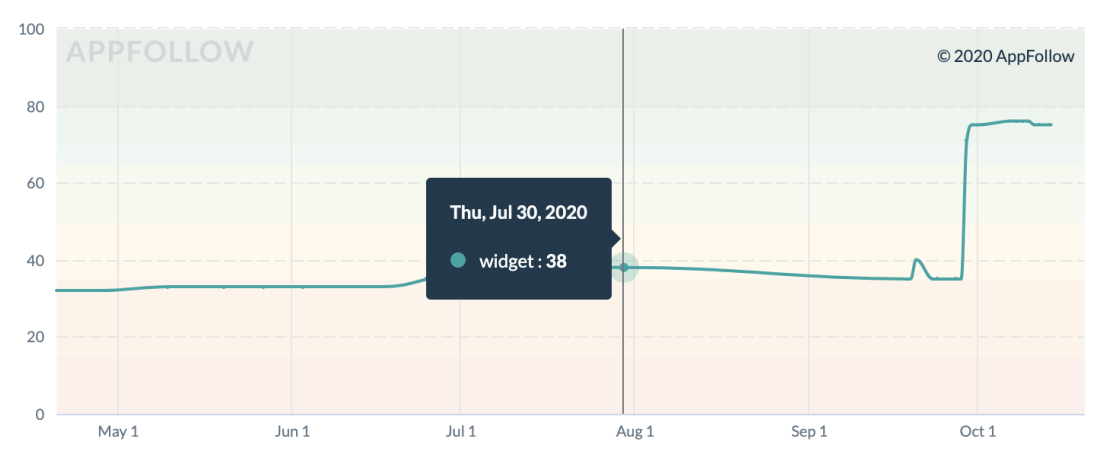6 App Metrics For Holiday Marketing Efficiency Measurement

Reading Time: 6 minutes
Who doesn’t like the spirit of the holidays? You’re probably thinking of gifts, hanging out with your friends (safely – wear your masks, people), and family. Christmas, Halloween, Easter- pumpkins, cobwebs, wreaths, and candles, every holiday has its own attribute.
| Bonus Content
👉 Holiday Marketing Guide 2020: Trends & Actionable Strategies 👉 Popular U.S. Bridalwear Brand Cocomelody Observes 30% More Sales |
In addition to attributes, there are also special offers, discounts, and promotions to attract customers. The same goes for the mobile market. The apps are products as well, and as such each holiday season, the App Store & Google Play spin out a colorful showcase of orange pumpkins, red caps, and snow. But before you try to capitalize on the holiday sentiments and adapt products to the seasons, let’s talk about the app metrics for holiday marketing efficiency measurement. All visible changes are aimed to boost external metrics and acquire more users while internal metrics are equally important.
Internal and external app metrics for holiday marketing efficiency measurement:
- Conversion rate: Once you’ve changed the graphics or text on the app page to accommodate the holiday spirit, it’s time to measure the effectiveness. If you update icons or screenshots the main external metric should be conversion rate from page view to installing, or CR from impression to install in App Store Search. How did these metrics change after the update?
- Installs: Many products during the seasons “sacrifice” their keywords in some text fields in favor of adding information about seasonal offers. Including but not limited to: discounts and holiday promo codes (e-commerce segment), additional seasonal loot and quests (games), new seasonal product innovations (utilities – live wallpaper, sticker app, etc.). This information can often be seen in the Subtitle fields, in promo texts (App Store), or in a short or full description (Google Play).When updating the texts, you should check how rankings with new keywords have changed. For example, the ‘Wish’ app has improved its rankings in the US Google Play after adding a new short description: 👻 Halloween deals are alive! 🧟♂️ Download now to shop 🎁Then you should check how search page views (or impressions in App Store) and installs were affected by that rankings improvement.A new app title and subtitles can also affect conversion rate in the same way as an icon or screenshots. We recommend updating text and graphics separately to measure its effectiveness in the correct way.
- Impressions and page views: Many marketers argue whether there even is a need for seasonal text optimization – in terms of using special keywords such as ‘Christmas’. The demand/popularity of these queries (and related holidays) really increases during the relevant holiday season. Below you may find a historical trend of the 2 examples of search popularity dynamic for ‘Christmas’ & ‘Halloween’.
The popularity of the ‘Christmas’ keyword is seeing a steady climb two months before Christmas:

Keyword Popularity Trend, source: AppFollow
The question is how and whether it is possible to use these queries for optimization in order to achieve an increase in search visibility and installations. In fact, the relevance of these queries to your product is very important. For example, if the app is in the online shopping category, “Christmas presents” can be a great seasonal key to your upgrade. A live wallpaper app with new Easter attributes in April can also be a successful seasonal keyword optimization.
However, you shouldn’t include such ‘holiday’ queries in your text meta if it’s not relevant. It is highly unlikely that users will search for a Sudoku game by the query of ‘Christmas present’.
- DAU/MAU: Seasonal in-product events are not only one of the ways of attracting new users, but also a method to retain current users. The introduction of additional seasonal functionality becomes an additional incentive for users to visit the app.
- Retention Rate: Correctly built content logic (for example, if we are talking about games, the system of daily rewards) will keep the user coming back to the app, encouraging them to login at least once a day.
- Revenue: Seasonal limited shopping deals are also a good way to boost your income. If we are to talk about the gaming segment, a loyal audience will be interested in getting limited and rare perks. Speaking of utilities, seasonal discounts on regular offers, or creating custom ones would be a good upgrade. It all depends on your ingenuity.
Seasonal marketing do’s and don’ts
Now that we are done discussing app metrics for holiday marketing, here are a few tactics that you should implement in your seasonal marketing strategy:
Do not be obvious: When you are looking at stores Search pages during the Christmas season, you may see that lots of apps are using the same attributes: Christmas candies, red hats, etc. Try not to be trivial and see what you can come up with, how to apply it, and make it relevant to your product.
Take into account local specifics: Different cultures have different customs and traditions. Don’t try to promote Christmas in Arab countries or Ramadan in Israel. Always consider the specifics of your key markets.
Apply for the season featuring: Games are predictably featured the most by the App Store during the holiday season. The next popular category is holiday stickers. Messengers, recipes, and shopping lists apps were also featured in the last few years.
You can have a great boost in browse traffic if you get featured in the App Store and Google Play. We recommend sending featuring requests a few weeks before the start of the holiday season. Having holiday-theme app pages or in-app events would increase the probability of featuring.

Featured Today in US App Store, source: AppFollow
Start your holiday activities early: You have to prepare the holiday app page and in-app events one month in advance. In this case, you will have enough time to run A/B tests in Google Play and check the metrics after updating graphics in the App Store.
Run A/B tests: Create separate tests for each metadata field: icon, screenshots, short description. So you’ll know the effect of each item. If your app has enough users in a few countries then also run country tests because the results can be different depending on the region and cultural differences.
These are the do’s and as for the don’ts, just do not make too many drastic changes and do not update anything for the sake of updating. Optimize wisely.
What to expect during the holiday season?
As we can see, the app stores already shine with holiday decor with creatives of many apps/games already full of snowflakes and Santa hats. From a creative perspective (in terms of graphic assets), classic ideas wander from year to year. The new trends for the current holiday season are not different in this regard. We definitely can not ignore some newly released features on the market.
So what about the latest trends?
- After the iOS 14 release, the widgets became more popular. If your application supports this feature, this is a good way to please your users with a seasonal widget design. Still wondering whether you need to have one? Take a look at the dynamic of the ‘widget’ keyword trend below:

Keyword Popularity Trend, source: AppFollow
- App Clips is another new feature offered by Apple. With it, you can offer users a unique experience with the key benefits of your app and adjust it for the holiday season. For example, e-commerce app clips can help users quickly receive holiday discounts and bonus cards or quickly find necessary seasonal goods.
- There is a new wave of COVID-19 related restrictions in many countries around the world, and in some of them, the lockdown is on again. There is a high chance that this Holiday season, many people will celebrate at home. Take this into account and prepare the proper seasonal content for your audience.
Key takeaways
In this paragraph, I think you expect to see something like: ‘Seasonal updates are the key to success and a great way to attract more users to your app’ or ‘Seasonal updates are a waste of resources, mobile users come to the mobile store to satisfy their need, for example, to find a new currency converter’. But it isn’t that simple. As with any marketing activity, the main takeaway is: ‘We need to test’. The practice of seasonal updates has been on the market for many years, but there is no universal answer to the question ‘will it work this time?’
The decision to make a seasonal product change (adding seasonal content) is made at the product level and many factors are taken into account, including team resources. Factors that can influence decision-making in this matter:
- the historical experience of the product (having a successful/unsuccessful experience in the past years)
- analysis of competitors (market)
- current team’s resources
With the unique challenges thrown across by the holiday season, you’d benefit from checking out the holiday marketing trends emerging these days and adapt accordingly. In any case, updating the application’s product page is certainly an easier task, but no one can guarantee that the new seasonal adaptation will convert users better.
Here’s What You Can Do Next
|













